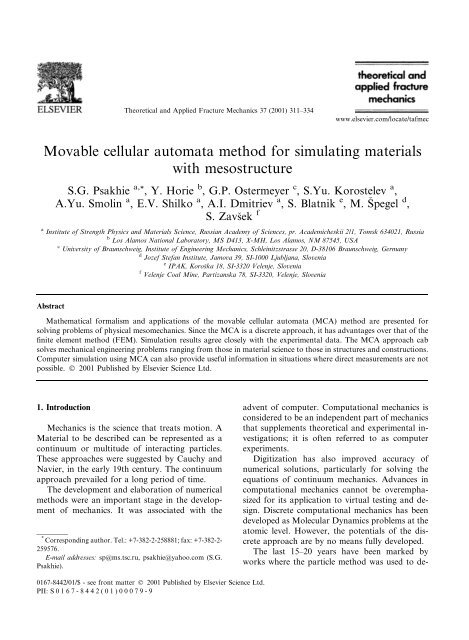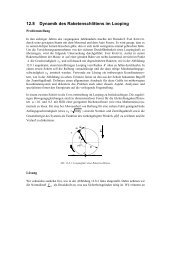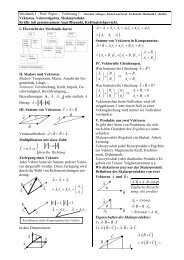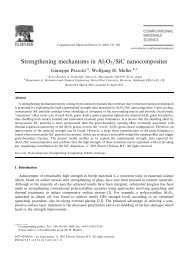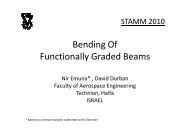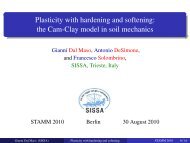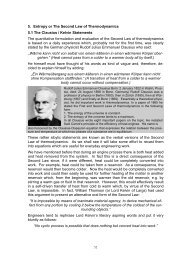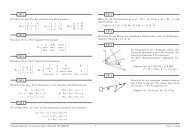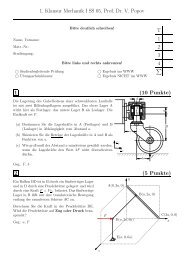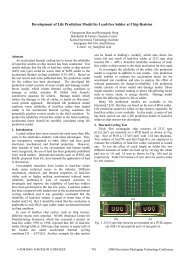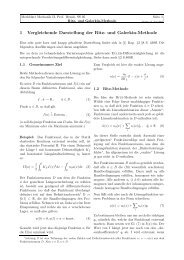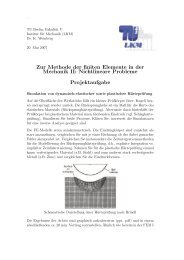Movable cellular automata method for simulating materials with ...
Movable cellular automata method for simulating materials with ...
Movable cellular automata method for simulating materials with ...
Create successful ePaper yourself
Turn your PDF publications into a flip-book with our unique Google optimized e-Paper software.
<strong>Movable</strong> <strong>cellular</strong> <strong>automata</strong> <strong>method</strong> <strong>for</strong> <strong>simulating</strong> <strong>materials</strong><br />
<strong>with</strong> mesostructure<br />
S.G. Psakhie a,* , Y. Horie b , G.P. Ostermeyer c , S.Yu. Korostelev a ,<br />
A.Yu. Smolin a , E.V. Shilko a , A.I. Dmitriev a , S. Blatnik e ,M.Spegel d ,<br />
S. Zavsek f<br />
a Institute of Strength Physics and Materials Science, Russian Academy of Sciences, pr. Academicheskii 2/1, Tomsk 634021, Russia<br />
b Los Alamos National Laboratory, MS D413, X-MH, Los Alamos, NM 87545, USA<br />
c University of Braunschweig, Institute of Engineering Mechanics, Schleinitzstrasse 20, D-38106Braunschweig, Germany<br />
d Jozef Stefan Institute, Jamova 39, SI-1000 Ljubljana, Slovenia<br />
e IPAK, Koroska 18, SI-3320 Velenje, Slovenia<br />
f Velenje Coal Mine, Partizanska 78, SI-3320, Velenje, Slovenia<br />
Abstract<br />
Mathematical <strong>for</strong>malism and applications of the movable <strong>cellular</strong> <strong>automata</strong> MCA) <strong>method</strong> are presented <strong>for</strong><br />
solving problems of physical mesomechanics. Since the MCA is a discrete approach, it has advantages over that of the<br />
®nite element <strong>method</strong> FEM). Simulation results agree closely <strong>with</strong> the experimental data. The MCA approach cab<br />
solves mechanical engineering problems ranging from those in material science to those in structures and constructions.<br />
Computer simulation using MCA can also provide useful in<strong>for</strong>mation in situations where direct measurements are not<br />
possible. Ó 2001 Published by Elsevier Science Ltd.<br />
1. Introduction<br />
Theoretical and Applied Fracture Mechanics 37 2001) 311±334<br />
Mechanics is the science that treats motion. A<br />
Material to be described can be represented as a<br />
continuum or multitude of interacting particles.<br />
These approaches were suggested by Cauchy and<br />
Navier, in the early 19th century. The continuum<br />
approach prevailed <strong>for</strong> a long period of time.<br />
The development and elaboration of numerical<br />
<strong>method</strong>s were an important stage in the development<br />
of mechanics. It was associated <strong>with</strong> the<br />
*<br />
Corresponding author. Tel.: +7-382-2-258881; fax: +7-382-2-<br />
259576.<br />
E-mail addresses: sp@ms.tsc.ru, psakhie@yahoo.com S.G.<br />
Psakhie).<br />
0167-8442/01/$ - see front matter Ó 2001 Published by Elsevier Science Ltd.<br />
PII: S 0 1 6 7 - 8 4 4 2 0 1 ) 0 0 079-9<br />
www.elsevier.com/locate/tafmec<br />
advent of computer. Computational mechanics is<br />
considered to be an independent part of mechanics<br />
that supplements theoretical and experimental investigations;<br />
it is often referred to as computer<br />
experiments.<br />
Digitization has also improved accuracy of<br />
numerical solutions, particularly <strong>for</strong> solving the<br />
equations of continuum mechanics. Advances in<br />
computational mechanics cannot be overemphasized<br />
<strong>for</strong> its application to virtual testing and design.<br />
Discrete computational mechanics has been<br />
developed as Molecular Dynamics problems at the<br />
atomic level. However, the potentials of the discrete<br />
approach are by no means fully developed.<br />
The last 15±20 years have been marked by<br />
works where the particle <strong>method</strong> was used to de
312 S.G. Psakhie et al. / Theoretical and Applied Fracture Mechanics 37 2001) 311±334<br />
scribe di€erent media including granular and loose<br />
<strong>materials</strong>. These works can be found in [1±11]. In<br />
addition to the conventional Newton±Euler<br />
equations of motion, moment equations are also<br />
used. Particle interaction including atoms) considers<br />
the nearest neighbor <strong>with</strong> a time step integration<br />
of equations of motion [12,13]. While the<br />
adiabatic assumption has made those analyses<br />
meso- and macrolevels involve certain arti®cial<br />
expedients when integrating equations of motion.<br />
Thus, the models based on the conventional<br />
Newton±Euler addresses point masses, even<br />
though they include the moment equations. To<br />
overcome this contradiction, the <strong>method</strong> of movable<br />
<strong>cellular</strong> <strong>automata</strong> MCA) [14±16] was developed<br />
by the authors in the framework of joint<br />
projects.<br />
2. MCA <strong>method</strong><br />
2.1. Basic approach<br />
Consider a system to be simulated by an ensemble<br />
of interacting <strong>automata</strong> elements) of ®nite<br />
size [16]. The concept of this <strong>method</strong> is based on<br />
the introduction of a new type of states, viz., the<br />
state of a pair of <strong>automata</strong>, into that of classical<br />
<strong>cellular</strong> <strong>automata</strong>. This has made possible a space<br />
variable that serves as a parameter of switching.<br />
The overlapping of a pair of <strong>automata</strong> was chosen<br />
as<br />
h ij ˆ r ij<br />
r ij<br />
0 ; …1†<br />
which is exhibited in Fig. 1a). The distance r ij<br />
between the centers of neighboring <strong>automata</strong> is<br />
shown in Fig. 1b) <strong>with</strong> d i being the <strong>automata</strong> size.<br />
For the simplest case, two states of pairs prevail:<br />
Linked state: h ij < h ij<br />
max ; …2†<br />
Unlinked state: h ij > h ij<br />
max : …3†<br />
The linked state is indicative of chemical bonds<br />
between elements and the unlinked state corresponds<br />
to the situation that there is no chemical<br />
bond between <strong>automata</strong>. Note that hij and rij are<br />
length parameters. They are capable of changing<br />
their positions in space and, consequently, changing<br />
the spatial arrangement of the entire system.<br />
The change in state of the <strong>automata</strong> pairs is governed<br />
by relative displacements of the <strong>automata</strong><br />
pair. It follows from Eqs. 2) and 3) that the given<br />
medium constituted by such pairs can be considered<br />
as a bistable medium.<br />
Consider a pair of <strong>automata</strong> ij. The state of this<br />
pair of <strong>automata</strong> is uniquely determined by two<br />
types of ®elds hab…t†. The ®rst is associated <strong>with</strong> the<br />
state of the pair itself ij±hij…t† and the second is<br />
associated <strong>with</strong> the states of its neighboring pairs<br />
fikg±hik and fjlg±hjl . It is worthy of note that<br />
these ®elds de®ne local de<strong>for</strong>mations de<strong>for</strong>mation<br />
of elements of the medium) and, consequently, the<br />
distribution and ¯uxes of elastic energy in the<br />
simulated medium.<br />
The time derivative hij…t† can be determined<br />
following the Viner±Rothenblute model [17]. The<br />
active bistable medium under study can be described<br />
by the equation<br />
Dh ij<br />
Fig. 1. Pair of <strong>automata</strong>: a) overlapping state, b) contact state.<br />
Dt ˆ f …hij †‡ X<br />
C…ij; ik†I…h<br />
k6ˆj<br />
ik †<br />
‡ X<br />
C…ij; jl†I…h jl †; …4†<br />
l6ˆi
S.G. Psakhie et al. / Theoretical and Applied Fracture Mechanics 37 2001) 311±334 313<br />
where the function f …hij † is indicative of the relative<br />
velocity of <strong>automata</strong> …V ij † and C…ij; ik…jl†† the<br />
coe cient associated <strong>with</strong> the transfer of the parameter<br />
h from the pair ik or jl) to the pair ij <strong>with</strong><br />
I…hik…jl† † being an explicit function of hik…jl† . Here<br />
hik…jl† de®nes the redistribution of the parameters<br />
hik and hjl between the pairs ij, ik, and jl. These<br />
parameters are shown in Fig. 2.<br />
Within the linear approximation, the function<br />
I…hik…jl† † can be written as<br />
I…h ik…jl† †ˆw…aij;ik…jl††V i…k†…j…l††<br />
n : …5†<br />
In general, the multiplier w…aij;ik…jl†† is a combination<br />
of trigonometrical functions and is de®ned by<br />
mutual arrangements of the <strong>automata</strong> ij, ik, and<br />
jl. Note that aij;ik…jl† is a set of values of the corresponding<br />
angles de®ned by the relative arrangement.<br />
The change in the overlapping parameter h ij <strong>for</strong><br />
the pair ij is de®ned by the following factors:<br />
· relative velocity between the elements i and j<br />
V ij );<br />
Fig. 2. Overlapping parameters <strong>for</strong> the pairs ij, ik, and jl.<br />
· change in the overlaps Dh ij ) of the ith automaton<br />
and its neighbors;<br />
· change in the overlaps Dh jl ) of the jth automaton<br />
and its neighbors.<br />
2.2. Motion of MCA<br />
It follows from Eq. 1) that the system consisting<br />
of movable <strong>cellular</strong> <strong>automata</strong> shall be described<br />
by the translational equations of motion<br />
given by<br />
d 2 h ij<br />
dt<br />
2 ˆ<br />
1 1<br />
‡<br />
mi mj pij ‡ X<br />
C…ij; ik†w…aij;ik†<br />
k6ˆj<br />
1<br />
pik<br />
mi ‡ X<br />
C…ij; jl†w…aij;jl† 1<br />
mj pjl : …6†<br />
l6ˆi<br />
To obtain Eq. 6), the term …d=dt†V i…j†k…l† was<br />
represented as …1=m i †p i…j†k…l† , where p i…j†k…l† is the<br />
<strong>for</strong>ce of inter-element interaction. It is de®ned by<br />
the function of the inter-<strong>automata</strong> response. The<br />
coe cient C…ij; ik…jl††, as stated in Eq. 4), is associated<br />
<strong>with</strong> the transfer of the parameter h from<br />
the pair ik or jl ) to the pair ij. The term w…aij;ik† in<br />
Eq. 5) is determined by the Poisson ratio and is<br />
related to the mutual arrangement of the pairs of<br />
elements ij and ik.<br />
The equations of motion <strong>for</strong> rotation can be<br />
written as<br />
d 2 h ij<br />
qij qji<br />
ˆ ‡<br />
dt2 J i J j<br />
‡ X<br />
l6ˆi<br />
s ij ‡ X<br />
k6ˆj<br />
S…ij; ik† qik<br />
sik<br />
J i<br />
S…ij; jl† qjl<br />
J j sjl : …7†<br />
Here, h ij is the angle of the relative rotation of<br />
elements switching parameter) similar to h ij ; q ij<br />
the distance from the center of the automaton i to<br />
the point of contact <strong>with</strong> the automaton j moment<br />
arm); s ij the tangential interaction of pairs; and<br />
S…ij; ik…jl†† the coe cients associated <strong>with</strong> the<br />
transfer of the parameter h from the pair ik or jl)<br />
to the pair ij. If C…ij; ik…jl†† ˆ 1 and<br />
S…ij; ik…jl†† ˆ 1, Eqs. 6) and 7) are completely<br />
equivalent to the Newton±Euler equations of<br />
motion <strong>for</strong> many-particle interaction.
314 S.G. Psakhie et al. / Theoretical and Applied Fracture Mechanics 37 2001) 311±334<br />
As noted above, the term C…ij; ik…jl†† determines<br />
the transfer of the parameter h from the pair<br />
ik or jl) to the pair ij. The term ``elastic in<strong>for</strong>mation''<br />
implies in<strong>for</strong>mation <strong>for</strong> relative elastic<br />
displacements of elements transferred to elastic<br />
®elds. Hence, equations of motion or Eqs. 6) and<br />
7) make it possible to allow <strong>for</strong> ``delays'' dt ij…ik†<br />
and dt ij…il† . This a€ects the overlapping parameter<br />
<strong>for</strong> the pairs {ik} and {jl} on the interaction of the<br />
pair of elements ij Fig. 2). The time lag is de®ned<br />
by the <strong>automata</strong> sizes, longitudinal and transverse<br />
sound velocities, and mutual arrangement of the<br />
pairs ij and ik or jl). It is obvious that the e€ects<br />
associated <strong>with</strong> generation and propagation of<br />
shock waves require particular attention.<br />
2.3. Volumetric changes<br />
For the <strong>method</strong> of embedded particles, Eqs.<br />
6)and 7) can be written as<br />
m i d2R i<br />
ˆ Fi<br />
dt2 X<br />
X<br />
‡ F ii ; j _i d 2~ i<br />
h X<br />
ˆ K<br />
dt2 ij ; …8†<br />
j<br />
where F i<br />
X is the volume-dependent <strong>for</strong>ce acting on<br />
the automaton i caused by the action of pressure<br />
from neighboring <strong>automata</strong>, F i ˆ pij ‡ sij . Here pij is the central component of the pair interaction<br />
<strong>for</strong>ce and sij the tangential component of this<br />
<strong>for</strong>ce. K ij ˆ qij…nij sij † is the unit vector nij de-<br />
®ned as n ij ˆ…R j R i †=…q ij ‡ q ji †.<br />
The volume-dependent <strong>for</strong>ce F i<br />
X acting on the<br />
automaton i due to the action of pressure from<br />
surroundings can be accounted <strong>for</strong> similar to the<br />
embedded atom <strong>method</strong> EAM) known from<br />
molecular dynamics [18]:<br />
F i<br />
X<br />
X<br />
ˆ P j S ij n ij : …9†<br />
j<br />
The index j …j ˆ 1; ...; N i † refers to <strong>automata</strong> in<br />
the linked state or the contact state <strong>with</strong> automaton<br />
i. It should be noted that P j is the pressure of<br />
the jth neighbor; S ij the area of contact of the<br />
automaton i <strong>with</strong> the automaton j; and n ij the unit<br />
vector of the normal to the contact area. Here n ij is<br />
directed towards the neighbor j. The automaton<br />
pressure is determined by the change in the auto-<br />
j<br />
mation volume. In the simplest linear) case this<br />
dependence takes the <strong>for</strong>m<br />
P j ˆ K j Xj X j<br />
0<br />
X j<br />
0<br />
where X j<br />
0<br />
; …10†<br />
is the initial equilibrium) automaton<br />
volume; X j the current automaton volume; and K j<br />
the bulk modulus. The simplest approximation<br />
corresponds to the change in the automaton volume<br />
<strong>for</strong> a time Dt. It can be determined from the<br />
corresponding changes in the distances Dq jk from<br />
the center of this automaton to the points of its<br />
contact <strong>with</strong> neighbors, i.e.,<br />
DX j j<br />
XN<br />
j<br />
ˆ X Dq jk<br />
j<br />
XN<br />
q jk<br />
,<br />
N j<br />
, !<br />
; …11†<br />
kˆ0<br />
kˆ0<br />
where N j is the number of neighbors of the automaton<br />
j.<br />
2.4. Response function<br />
For each automation, the relative de<strong>for</strong>mation<br />
e ij is introduced. Refer to Fig. 3. The parameter q ij<br />
is the distance between the mass center of the automaton<br />
i and the point of its contact <strong>with</strong> the<br />
automaton j.<br />
It is possible to set aside four basic types of the<br />
response function Fig. 4). For the simplest case,<br />
the inter-<strong>automata</strong> interaction is assumed elastic<br />
and linear. Hence, the response function can be<br />
treated as a linear function of the overlapping<br />
parameter, Fig. 4a). The switching of the <strong>automata</strong><br />
pair from the linked to unlinked state occurs<br />
when their overlapping reaches a value corresponding<br />
to rc.<br />
Fig. 3. Scheme <strong>for</strong> calculating relative de<strong>for</strong>mation of <strong>automata</strong>.
S.G. Psakhie et al. / Theoretical and Applied Fracture Mechanics 37 2001) 311±334 315<br />
Fig. 4. Di€erent types of material response: a) linear, b) concrete like material, c) plastic de<strong>for</strong>mation, d) plastic ¯ow and<br />
degradation.<br />
To account <strong>for</strong> damage at a scale level lower<br />
than the automation size, the linear response<br />
function should be modi®ed. Fig. 4b) represents<br />
the response. The e€ective Young's modulus decreases<br />
due to degradation corresponding to a given<br />
load higher than rd. This degradation is<br />
caused by damage generation. Note that the linear<br />
response is observed in the range of loading<br />
h0 rdi whereas in the range of hrd rci damages<br />
are generated <strong>with</strong>in <strong>automata</strong>. The response<br />
function is nonlinear in character. Unloading is<br />
de®ned by a new Young's modulus represented by<br />
dotted lines in Fig. 4b). For each point of the<br />
response, see points 1 and 2 in the range of<br />
hrd rci, the Young's moduli are di€erent. The<br />
response in Fig. 4a) and b) can be used <strong>for</strong> <strong>simulating</strong><br />
the process of fracture of brittle <strong>materials</strong><br />
such as ceramics, concrete, etc., and constructions<br />
designed based on such <strong>materials</strong>. The responses<br />
<strong>for</strong> irreversible <strong>materials</strong> behavior are shown in<br />
Fig. 4c) and d). Presented in Fig. 4c) is plastic<br />
de<strong>for</strong>mation while Fig. 4d) represents a combination<br />
of plastic ¯ow and material degradation.<br />
The response of irreversible behavior, say plastic<br />
de<strong>for</strong>mation, requires an intimate knowledge of<br />
the mechanisms of plastic ¯ow initiation and<br />
evolution [19,20].<br />
Nevertheless, the MCA <strong>method</strong> could be applied<br />
to simulate the behavior of specimens and<br />
structures provided that detail in<strong>for</strong>mation is<br />
available on the material behavior in the region of<br />
plastic ¯ow. The MCA <strong>method</strong> could simulate the<br />
processes of elastoplastic de<strong>for</strong>mation and material<br />
degradation at the meso- and microlevels selecting<br />
appropriate response functions <strong>for</strong> the<br />
movable <strong>automata</strong> [14±16,21].<br />
2.5. Surface interaction<br />
When <strong>simulating</strong> surface friction using the<br />
particle approach, a serious problem arises <strong>with</strong><br />
reference to the correct setting of surface structures<br />
and interaction. Modeling the solid as a set<br />
of particles, all surfaces are assumed to be arti®cially<br />
rough and regular. It can be seen from Fig. 5<br />
that the roughness characteristics are associated<br />
<strong>with</strong> the element size.
316 S.G. Psakhie et al. / Theoretical and Applied Fracture Mechanics 37 2001) 311±334<br />
Fig. 5. Arti®cial structure of surfaces <strong>for</strong> two contacting solids<br />
simulated as a set of particles.<br />
In general, three levels of a real surface will be<br />
considered. They are referred to as the macrolevel<br />
solid as whole), microlevel voids, small cracks,<br />
etc.) and mesolevel intermediate properties of the<br />
two just mentioned) [22,23].<br />
Two ways of <strong>simulating</strong> a contact surface are:<br />
· The <strong>automata</strong> sizes are speci®ed to be so small<br />
that they describe topologically) the real surface<br />
roughness. This allows direct investigation<br />
of the processes at all three scale levels mentioned.<br />
In this case the surface roughness, material<br />
inhomogeneity, and other structural defects<br />
such as damages, cracks, etc.) can be introduced<br />
in an explicit <strong>for</strong>m through the topology<br />
of a surface layer.<br />
· The <strong>automata</strong> sizes are speci®ed to be so large<br />
that they consider the contacting surface as a<br />
plane <strong>with</strong> roughness preset directly at a lower<br />
level. Such an approximation makes it possible<br />
to cover the macro- and mesolevels. The interaction<br />
of two contacting surfaces can be described<br />
by introducing friction <strong>for</strong>ces, which depend on<br />
the microparameters of the surface.<br />
Even <strong>with</strong> the advent of modern high-power<br />
computers, the ®rst approach is limited to examination<br />
of small areas of contacting surfaces,<br />
Fig. 6a) because a great number of elements is<br />
required to describe a real surface. On the other<br />
hand, such an approximation can be used to<br />
study the mechanisms of very intricate processes<br />
occurring in surface layers of <strong>materials</strong>, e.g.,<br />
damage generation and accumulation, crack<br />
propagation, changes in the surface pro®le,<br />
structure, and composition of <strong>materials</strong> near the<br />
surface. The results can be useful <strong>for</strong> understanding<br />
the causes and tendencies of phenomena<br />
at the mesolevel. However, the results <strong>for</strong> an element<br />
may not be su cient to simulate the interaction<br />
of two contacting surfaces at the<br />
macrolevel.<br />
Fig. 6. Description of contacting surfaces: a) direct setting of micro-roughness, b) indirect setting at the meso-level.
The second approach considers the contacting<br />
surfaces as a set of segments <strong>for</strong> the two-dimensional<br />
2D) case and surface elements <strong>for</strong> the 3D<br />
case. The 3D case is shown schematically in Fig.<br />
6b). The <strong>automata</strong> i and j correspond to the lower<br />
surface and the automaton k corresponds to the<br />
upper surface. The pair i±j is considered as a segment<br />
interacting <strong>with</strong> the automaton k.<br />
Two types of ``segment±element'' interaction<br />
will be used. They correspond to the normal potential<br />
interaction and tangential friction <strong>for</strong>ce.<br />
The normal interaction is de®ned by the height<br />
h between the element k and segments i±j. The<br />
normal <strong>for</strong>ce is applied to each automation of the<br />
triangle k±i±j according to<br />
· F k…ij† is the <strong>for</strong>ce acting on the automaton k from<br />
the side of the segment i±j:<br />
F k…ij† h k…ij†<br />
n ˆ E hk…ij†<br />
n<br />
h k…ij†<br />
0<br />
h k…ij†<br />
0<br />
!<br />
: …12†<br />
· F …ij†k is the <strong>for</strong>ce acting from the side of the automaton<br />
k on the element j as a part of the segment<br />
i±j:<br />
F …ji†k h k…ij†<br />
n<br />
ˆ Elj<br />
r ij<br />
h k…ij†<br />
n<br />
h k…ij†<br />
0<br />
h k…ij†<br />
0<br />
!<br />
: …13†<br />
· F …ji†k is the <strong>for</strong>ce acting from the side of the automaton<br />
k on the element j as a part of the segment<br />
i±j:<br />
F …ji†k h k…ij†<br />
n<br />
ˆ Eli<br />
r ij<br />
S.G. Psakhie et al. / Theoretical and Applied Fracture Mechanics 37 2001) 311±334 317<br />
h k…ij†<br />
n<br />
h k…ij†<br />
0<br />
h k…ij†<br />
0<br />
!<br />
: …14†<br />
The equilibrium distance height) h0 <strong>for</strong> the ``segment±element''<br />
interaction is de®ned as h0 ˆ 3<br />
p R,<br />
where R is the automaton radius. It can be seen<br />
that F k…ij† ˆ F …ij†k ‡ F …ji†k .<br />
The tangential interaction of two contacting<br />
surfaces is described by the dissipative friction<br />
<strong>for</strong>ce. Mesofragments of the contacting surfaces<br />
are considered as plane. Hence, the tangential interaction<br />
``segment±element'' can be written. Analogues<br />
to Eqs. 12)±14), it can be shown that<br />
F k…ij†<br />
R …Vs† ˆFR; …15†<br />
F …ij†k<br />
R …Vs†<br />
j FRl<br />
ˆ<br />
rij ; …16†<br />
F …ji†k<br />
R …Vs†<br />
j FRl<br />
ˆ<br />
rij ; …17†<br />
where FR is the local friction <strong>for</strong>ce. The resistance<br />
to the relative tangential displacement is de®ned<br />
by the surface roughness characteristics at the<br />
microlevel. In the present work the general expression<br />
<strong>for</strong> the local <strong>for</strong>ce of friction at the mesolevel<br />
has the <strong>for</strong>m<br />
FR ˆ l0Vs ‡ f …l1; Kl; rN; r0; Vs†: …18†<br />
The ®rst part in Eq. 18) represents viscous friction<br />
and the second part describes friction resulting<br />
from local interaction of contacting surfaces. Here,<br />
Vs is the tangential velocity; l0 the viscous friction<br />
coe cient; f is some function; l1 the friction coe<br />
cient <strong>for</strong> dry surfaces; rN the normal compressive<br />
stresses; r0 the elastic limit; and Kl a special<br />
variable describing the local resistance due to the<br />
relative tangential displacement of contacting<br />
surfaces at the microlevel. In general, the parameters<br />
l0; l1; rN, and Kl are complex functions of<br />
di€erent microscale factors such as the local pro®le<br />
of the contact surface n, history of interaction L,<br />
tangential velocity Vs, local compressive normal<br />
stresses rlocal N , local temperature T local , etc. The<br />
variable Kl is also a function of the average contact<br />
area S. Di€erent <strong>for</strong>ms of the dependence of<br />
Eq. 18) on the variables have been used to study<br />
the friction e€ects at the meso- and macrolevels<br />
[24,25]. In practice, use is often made of the macrocharacteristics<br />
such as the coe cient of friction<br />
of two surfaces:<br />
ldr ˆ Fdr<br />
: …19†<br />
FN<br />
In Eq. 19), Fdr is the resistance of the contacting<br />
solids to relative tangential movement and FN is<br />
the applied normal <strong>for</strong>ce. It is possible to obtain<br />
di€erent <strong>for</strong>ms <strong>for</strong> ldr <strong>with</strong> reference to friction<br />
time and frequency, path covered, initial temperature,<br />
and surface state and other frictional characteristics<br />
at the mesoscale level.<br />
2.6. Surface microroughness<br />
The variable Kl, describes the microroughness.<br />
It is a real dependence Kl…n† as shown in Fig. 7a)
318 S.G. Psakhie et al. / Theoretical and Applied Fracture Mechanics 37 2001) 311±334<br />
Fig. 7. Surfaces roughness characteristics: a) experiment, b) MCA approximation, c) parameters characterizing roughness.<br />
and is approximated by the superposition of two<br />
piecewise-periodic functions, Fig. 7b). Periodic<br />
fragments of the approximated function are described<br />
by sinusoids:<br />
Kn ˆ An 1<br />
A sin p xn 1 `1<br />
`1<br />
x n 1<br />
1 ˆ xn<br />
1<br />
x n 1<br />
2 ˆ xn<br />
2<br />
n<br />
‡ Vs Dt;<br />
n<br />
‡ Vs Dt:<br />
‡ An 2<br />
A sin p xn 2 `2<br />
`2<br />
;<br />
…20†<br />
Here n is the number of a time step while A1…2† and<br />
`1…2† are the amplitude and half-period of a sinusoid,<br />
respectively. The current value of the coordinate<br />
axis x is directed along the contact surface<br />
line tangential direction). The indices 1 and 2 indicate<br />
the number of a sinusoid while A is the size<br />
of a representative mesovolume.<br />
The ®rst sinusoid number 1) in Eq. 20) is<br />
considered as the ®rst approximation of the real<br />
dependence Kl…n†. The second sinusoid marked 2)<br />
is approximation of the real pro®le, Fig. 7b). Each<br />
sinusoidal component of the complex curve Kl…n†<br />
has its own eigenvalue of the amplitude A0 which<br />
correlates <strong>with</strong> the average values of amplitudes<br />
given <strong>for</strong> the ®rst and second sinusoids A aver<br />
1…2† Fig.<br />
2.7c)).<br />
To estimate the characteristic length of the<br />
curve Kl…n†, the parameters d1 and d2 are introduced,<br />
Fig. 7c). Each periodic sinusoidal) portion<br />
of the curve has its own length, that correlates <strong>with</strong><br />
the average value of d1…2† and those <strong>for</strong> A max<br />
1…2† and<br />
`1…2† . They can be obtained from experiments and/<br />
or theory using the models in [22,23,25].<br />
In general, the curve Kl…x† oscillates about<br />
some average value of Kav l , greater than zero. This<br />
value is independent of FN and can be determined<br />
only by the contact pro®le of the surfaces. The<br />
condition Kav l > 0 is governed by the surface<br />
characteristics such as pits, etc.<br />
And quanti®ed by the characteristic length R at<br />
the mesolevel. The interaction of two bumps at the<br />
microlevel of the ``stick±slip'' mechanism and<br />
Kav l ˆ 0. With two <strong>cellular</strong> <strong>automata</strong> interacting at<br />
the mesolevel, irrespective of the interaction of the<br />
basic mechanisms there always exists some surfaces<br />
such that Kmin l > 0: Note that the oscillation<br />
amplitude Kl decreases to zero <strong>with</strong> increasing R.
2.7. Energy dissipation<br />
Eqs. 6) and 7) describe the systems behavior<br />
<strong>for</strong> constant total mechanical energy. To include<br />
energy dissipation, <strong>for</strong> instance heat generation<br />
consider Lagrange function of the <strong>automata</strong> ensemble<br />
that depends on the generalized coordinates<br />
q and generalized velocities _q as<br />
L ˆ K U;<br />
where K ˆ K…†is _q kinetic energy and U ˆ Uq … † is<br />
potential energy. The equation of motion is<br />
d oL oL oD<br />
‡ ˆ 0; …21†<br />
dt o_q oq o_q<br />
where the dot denotes time di€erentiation,<br />
D ˆ D…_q† is additional function depending on<br />
generalized velocities only; it accounts <strong>for</strong> dissipation.<br />
Introduce the temperature T as<br />
Cvm _T ˆ oD<br />
o_q _q;<br />
where Cv is speci®c heat capacity and m is the<br />
automaton mass. Eq. 21) the result is<br />
_L ˆ oL d<br />
q ‡<br />
o_q dt<br />
oL<br />
o_q<br />
‡ oD<br />
o_q _q:<br />
It is possible to show that the equations of motion<br />
can be written as<br />
L<br />
oL<br />
o_q _q CV mT ˆ 0<br />
or<br />
‰ K ‡U ‡ CV mT Š ˆ 0: …22†<br />
It follows from Eq. 22) that the expression in<br />
brackets represents the total energy <strong>with</strong> dissipation<br />
that is constant in time.<br />
3. Transient to steady-state de<strong>for</strong>mation<br />
3.1. Problem description<br />
S.G. Psakhie et al. / Theoretical and Applied Fracture Mechanics 37 2001) 311±334 319<br />
Material has been studied either during steady<br />
mode of de<strong>for</strong>mation or at the onset of fracture<br />
[26,27]. Material behavior at the initial stages of<br />
de<strong>for</strong>mation remain has not much attention. Experimental<br />
study of the problem is possible only by<br />
total de<strong>for</strong>mation, acousto-emission spectra, etc.<br />
Even in this case, higher time precision in the<br />
range 10 6 ±10 9 s measurement equipment is<br />
necessary. Spatial distribution of de<strong>for</strong>mation may<br />
be obtained <strong>with</strong> high accuracy using the special<br />
television-optics system [28,29]. Displacement<br />
vectors can be assessed on the surface of the de<strong>for</strong>med<br />
material <strong>with</strong> the accuracy of 1500 points<br />
per 1 mm 2 . With high time resolution details of<br />
transition to stationary de<strong>for</strong>mation mode at the<br />
mesolevel can be found. Discrete approaches<br />
[12,30±36] are also being widely used in de<strong>for</strong>mation<br />
studies. In what follows, the <strong>method</strong> of MCA<br />
[32±36] will be applied to obtain the response of<br />
solids at the transition stage when the material<br />
de<strong>for</strong>mation occurs already.<br />
3.2. Modeling consideration<br />
A 2D sample is simulated to study the material<br />
response at the mesolevel under load. The structure<br />
of the sample is shown in Fig. 8a). The <strong>automata</strong><br />
are taken to be pure Ni or Al [37].<br />
Considered are uniaxial tension and compression<br />
<strong>with</strong> the constant rate VY . The load is applied<br />
to the bottom part of the sample. Calculations are<br />
made <strong>for</strong> three di€erent loading rates<br />
VY ˆ 10 cm=s; VY ˆ 1cm=s and VY ˆ 0:1<br />
cm=s.<br />
It was shown in [34], that the tension of Ni<br />
samples reached the steady-state of de<strong>for</strong>mation<br />
when t ˆ 5 ls. The ¯at steady-state de<strong>for</strong>mation<br />
begins to propagate at t ˆ 0:05 ls. Evolution of<br />
velocity ®eld shows the region of compressive<br />
stresses follows the front along the material surface.<br />
The size of this region is about 30 lm along<br />
the OY axis, Fig. 8b) <strong>for</strong> an automaton of size 4<br />
lm. This compression region propagates immediately<br />
after the wave front reaches the steady-state<br />
of de<strong>for</strong>mation. This region is not a€ected by<br />
surface defects. That inner structure of the velocity<br />
distribution, however, is a€ected by surface defect.<br />
Such features are expected to be observed from the<br />
acousto-emission spectra.<br />
Additional work in [34] shows that such regions<br />
present in compression were attributed to the
320 S.G. Psakhie et al. / Theoretical and Applied Fracture Mechanics 37 2001) 311±334<br />
Fig. 8. Linked <strong>automata</strong> …4 lm† connected <strong>with</strong> lines <strong>for</strong> specimen X ˆ 0:1 mm, and Y ˆ 0:2 mm: a) sample structure, b) velocity<br />
®eld at t ˆ 0:26 lm and VY ˆ 10 cm=s.<br />
tendency of the material to keep its initial volume.<br />
Such regions also arise in surface layer where the<br />
material is free to move in direction normal to<br />
applied loading. For periodic boundary conditions<br />
on the lateral boundary of the sample, compressive<br />
regions were not detected. Once the compression<br />
region is generated, it propagates along the surface<br />
<strong>with</strong> the velocity of transversal acoustic wave. It<br />
propagates into the bulk of the material <strong>with</strong> the<br />
speed of longitudinal acoustic wave. Calculations<br />
have shown that the compression regions propagate<br />
into the material from two opposite sides of<br />
the material. They interfere and destroy each<br />
other. For hardened surface where the elastic<br />
moduli of the surface <strong>automata</strong> are increased by 2±<br />
4 times, the speed of propagation of the compression<br />
region along the surface was found to be<br />
increased by 10±15%.<br />
In reality, the loading may not be oriented<br />
along the sample axis. Shear stress may prevail. It<br />
is there<strong>for</strong>e relevant to study aluminum samples<br />
subjected to tension + shear <strong>with</strong> VX ˆ 12:5 m=s<br />
and VY ˆ 3:75 m=s, compression + shear <strong>with</strong><br />
VX ˆ 12:5 m=s and VY ˆ 3:75 m=s is also considered.<br />
The structure of the sample is shown in<br />
Fig. 8a). The size of each automaton was<br />
3 lm.<br />
Preliminary MCA calculations show that <strong>for</strong><br />
the combination of shear loading and free surface<br />
steady ``vortex'' associated <strong>with</strong> elastic de<strong>for</strong>mations<br />
move <strong>with</strong> a velocity determined by the<br />
transverse acoustic wave. Distribution of elastic<br />
de<strong>for</strong>mation during the transitory period be<strong>for</strong>e it<br />
becomes steady is highly non-uni<strong>for</strong>m [35]. Fig.<br />
9a) shows the velocity ®eld and a schematic distribution<br />
of directions of elastic displacements.<br />
Fig. 9b) exhibits the initial <strong>for</strong>mation of ``vortex''.<br />
This is caused by the in¯uence of free surface as in<br />
the case of tensile load. The surface properties<br />
in¯uence the shape of the ``vortex'' that depends<br />
on its generation and propagation features. For a<br />
hardened surface the vortex is more localized and<br />
tends to be <strong>for</strong>med deeper into the material. Deeper<br />
vortex generation corresponds to wider samples.<br />
The generation of vortex appears to be<br />
associated <strong>with</strong> the interaction of two compression<br />
regions one of which propagates from the loaded<br />
surface and the other is re¯ected by lateral surface<br />
of the sample.<br />
To reiterate, the simulated de<strong>for</strong>mation under<br />
tension is also of the vortex type caused by the<br />
free surface. The ``vortex'' is <strong>for</strong>med on the opposite<br />
side of the sample as compared to compression.<br />
For a long sample the vortex at the
S.G. Psakhie et al. / Theoretical and Applied Fracture Mechanics 37 2001) 311±334 321<br />
Fig. 9. Combined shear loading and free surface steady vertex: a) velocity ®eld at t ˆ 0:022 ls compression + shear), b) direction of<br />
elastic displacements.<br />
opposite side of the sample has an opposite rotation.<br />
The process of new vortex generation can<br />
be divided into four stages. At the ®rst stage, it is<br />
possible to de®ne a wide enough band of uni<strong>for</strong>m<br />
displacements <strong>with</strong> shear component Figs. 10a)<br />
and b). The band is located ahead of the vortex.<br />
The second stage pertains to the core of a new<br />
vortex in Fig. 10c) that appears lower than the<br />
displacement band at the lateral surface. It is<br />
opposite to the shear component direction. At the<br />
third stage, this new vortex grows and departs<br />
from the initial vortex, Fig. 10d). At the fourth<br />
stage, the sizes and velocities of the new and<br />
initial vortices are equalized. The distance between<br />
the vortices is determined by the size of the<br />
sample and its elastic properties. Thus the transient<br />
to steady mode of de<strong>for</strong>mation in long<br />
samples may be identi®ed by wavy displacement<br />
®eld.<br />
Thus, according to the obtained results, the<br />
stressed state of the material is essentially nonuni<strong>for</strong>m<br />
even at the stage of transient to steady<br />
mode of de<strong>for</strong>mation.<br />
4. Computer aided design of concrete material and<br />
structures<br />
4.1. Preliminary remarks<br />
Concrete is a highly heterogeneous material. Its<br />
response can change dramatically <strong>with</strong> load type.<br />
For instance, structures that may be safe under<br />
normal conditions can be destroyed by a relatively<br />
insigni®cant movement of the soil during an<br />
earthquake.<br />
The MCA approach will be applied:<br />
· to study the fracture process of concrete specimens<br />
and structures,<br />
· to develop computer-aided design procedures<br />
<strong>for</strong> concrete members and constructions,<br />
· to propose an architecture of an intellectual<br />
electronic dynamic monitoring system <strong>for</strong> acquisition,<br />
storage, communication and data processing<br />
of full-scale experiments on fracture of<br />
real structures and show the possibility of applying<br />
the MCA <strong>method</strong> to predict vulnerability of<br />
structures.
322 S.G. Psakhie et al. / Theoretical and Applied Fracture Mechanics 37 2001) 311±334<br />
Fig. 10. Velocity ®eld <strong>for</strong> a long sample at di€erent time: a) t ˆ 0:065 ls, b) enlarged section of a), c) t ˆ 0:095 ls, d) t ˆ 0:165 ls.
4.2. Concrete specimen<br />
S.G. Psakhie et al. / Theoretical and Applied Fracture Mechanics 37 2001) 311±334 323<br />
Cement paste and aggregates are the main<br />
constituents of concrete. The strength of concrete<br />
depends on their properties and curing conditions.<br />
According to the MCA <strong>method</strong>, the inner structure<br />
of concrete specimens can be represented by<br />
two types of <strong>automata</strong>. First <strong>automata</strong> consist of<br />
the properties of cement paste and second <strong>with</strong><br />
properties of aggregates. The MCA computer-aided<br />
design of concrete can be made following the<br />
scheme:<br />
Step 1: Uniaxial compression test of cement and<br />
aggregates are made. The results are presented in<br />
terms of the stress±strain diagrams as shown in<br />
Fig. 11. Note that the MCA simulation ®ts the<br />
data well.<br />
Step 2: Consider a concrete specimen 15 cm in<br />
the OX direction and 30 cm in the OY direction.<br />
The inner structure of the specimen is generated by<br />
``computer-aided mixing'' of the aggregate and<br />
cement paste <strong>automata</strong>. The resulting concrete<br />
specimen is shown in Fig. 12. Concentration of<br />
aggregate-<strong>automata</strong> is about 52%.<br />
Step 3: The computer simulated concrete specimen<br />
is subjected to uniaxial loading <strong>with</strong> a constant<br />
rate. The stress±strain diagrams of<br />
experimental test [38] and MCA simulation are<br />
Fig. 11. Stress±strain diagrams <strong>for</strong> cement paste and aggregate.<br />
Fig. 12. Concrete specimen.<br />
shown in Fig. 13. Note that the obtained results<br />
are very close to experimental data.<br />
Modeling results based on MCA, show good<br />
agreement <strong>with</strong> experimental data <strong>for</strong> strength<br />
properties and fracture patterns [38].<br />
Fig. 13. Stress±strain diagrams of experimental test and MCA<br />
simulation.
324 S.G. Psakhie et al. / Theoretical and Applied Fracture Mechanics 37 2001) 311±334<br />
4.3. Dynamic tests of structures<br />
Consider the fracture behavior of a two-story<br />
frame under shear-type de<strong>for</strong>mation imitating<br />
earth crust movement during an earthquake.<br />
Fig. 14. Loading scheme of the sample all units in cm).<br />
(a)<br />
(b)<br />
Fig. 14 shows the loading scheme. Fig. 14 shows<br />
that the stationary stopper limits the movement of<br />
the ``roof''. Bottom of the structure models the<br />
foundation lying on the earth and shifted <strong>with</strong> it<br />
during an earthquake. A separate automaton of<br />
the structure was considered as the concrete. The<br />
mechanical properties of an automaton coincide<br />
<strong>with</strong> those found previously using MCA CAD.<br />
Speci®c characteristics of <strong>cellular</strong> <strong>automata</strong> and<br />
parameters of inter-element interaction were<br />
measured using the parameters of high-strength<br />
concrete. Damping of the upper ¯oor of the<br />
structure <strong>with</strong> a stationary stopper Fig. 14) controls<br />
the bending type of structure de<strong>for</strong>mation.<br />
Fig. 15a) shows the primary of the fracture patterns<br />
under the above mentioned loading conditions.<br />
Fig. 15b) shows the prime stages of<br />
structure fracture <strong>for</strong> the thickened middle beam.<br />
Note that cracks are ®rst initiated and grow near<br />
the butt-joints where the middle beam is connected<br />
Fig. 15. Structure of inter-element bonds at di€erent stages of fracture: a) primary fracture patterns, b) fracture patterns <strong>for</strong><br />
thickened mid section.
S.G. Psakhie et al. / Theoretical and Applied Fracture Mechanics 37 2001) 311±334 325<br />
to the walls of the structure. The MCA <strong>method</strong><br />
makes it possible to analyze the design modi®cations<br />
of the frame in order to delay structure<br />
fracture.<br />
4.4. Intelligent expert systems <strong>for</strong> viability analysis<br />
of structures<br />
To design an acquisition system <strong>for</strong> measuring,<br />
storing and monitoring the displacements of selected<br />
points on an object undergoing dynamic<br />
loading, a high rate of network data exchange<br />
among the nodes is needed.<br />
The MCA <strong>method</strong> requires each module to be<br />
capable of executing at least 10 Kmeasurements<br />
per second <strong>with</strong>in a large range of acceleration<br />
values. Furthermore, it should contain acceleration<br />
sensors capable of measuring in 3D and<br />
storage capacity of the order of 100 Kvalues<br />
<strong>with</strong>in a few seconds. Hence, the sensor modules<br />
should be robust enough to <strong>with</strong>stand and survive<br />
the impact of building collapse. That is the monitoring<br />
connections should be intact so that the<br />
crash data can be extracted from the module <strong>for</strong><br />
subsequent analysis using the MCA system. Depending<br />
on the type of crash data needed, the acquisition<br />
system may require several hundred<br />
modules.<br />
Fig. 16. Flow chart of sensor module.<br />
Acceleration sensor technologies have improved<br />
primarily <strong>with</strong> reference to monitoring crash<br />
data). However, their application is complex. As<br />
shown in the block diagram of the sensor module<br />
designed Fig. 16), an array of sensors are analog<br />
multiplexed to an A/D converter that feeds a FIFO<br />
RAM <strong>with</strong> sample values under control of rangedependent<br />
sensor selection logic. Even more di -<br />
cult is the power supply and synchronization, that<br />
is synchronization of samples in separate modules.<br />
The high sampling frequency and the possible<br />
breakdown of network connection will require<br />
more advanced design considerations to assume<br />
reliable operation under high-G conditions. Accuracy<br />
and safety features should be implemented<br />
in the module such that response of order of several<br />
microseconds could be maintained <strong>for</strong> about<br />
ten seconds after the loss of external synchronization<br />
due to wire disconnection.<br />
The sensory modules are attached to the network<br />
as shown in Fig. 17. The network controller<br />
is located at a safe remote place away from the<br />
crash site. Two types of network architecture are<br />
need <strong>for</strong> sensor modules <strong>with</strong> reference to their<br />
data storage and transmission capabilities. The<br />
®rst pertains to local data storage and slow<br />
transmission to the host system after termination<br />
failure. The second consists of modules from
326 S.G. Psakhie et al. / Theoretical and Applied Fracture Mechanics 37 2001) 311±334<br />
which data are to be transmitted in real-time and<br />
minimizing the loss of communication due to<br />
possible sensor destruction. In view of the large<br />
number of sensor modules using a combined<br />
approach may be the best solution. For the case<br />
of microprocessor-based including Neuronbased)<br />
intelligent modules, generation and transmission<br />
of alarm events based on thresholds of<br />
acceleration values could be implemented. Another<br />
technology is digital signal processing <strong>for</strong><br />
e cient compression and bu€ering of data recorded.<br />
Coarse values of acceleration can be transmitted<br />
during execution of the crash test in real-time<br />
to support the planned real-time functions of the<br />
MCA system. Note that most of the data collected<br />
during execution of the test will be stored locally<br />
and will be subsequently transmitted through the<br />
network to the MCA system <strong>for</strong> further analysis.<br />
This makes it possible to combine the MCA<br />
<strong>method</strong> and the sensor system suggested above<br />
into one intellectual integrated system. The resulting<br />
system allows one not only to carry out<br />
monitoring of structures and constructions but<br />
Fig. 17. Diagram of sensor-module connections.<br />
also to expert their vulnerability under di€erent<br />
loading conditions.<br />
5. Computer aided examination of strength properties<br />
of lignite<br />
5.1. Statement of problem<br />
Danger of mine roof and wall collapse is an<br />
important problem <strong>for</strong> coal mining [39]. For examination<br />
of the collapse hazard of coal-beds and<br />
<strong>for</strong> design of protective structures, knowledge<br />
about strength properties and fracture features of<br />
coal is extremely important. Lignite is a strongly<br />
marked heterogeneous material. There<strong>for</strong>e, elastic<br />
characteristics, strength properties as well as<br />
mechanisms of lignite fracture can be changed<br />
dramatically even under small changing of its<br />
composition or loading conditions.<br />
For safety of coal mining, <strong>for</strong>ecasting of tunnel<br />
roof and wall collapse is one of utmost importance.<br />
The sudden outbursts of coal and gas could<br />
lead to collapse and delay construction of the mine
oadways of the uncaved portion. The Velenje coal<br />
mine one of the biggest mines in Europe) there<br />
has experienced 7 such accidents <strong>with</strong> 11 dead<br />
miners since 1958.<br />
Experimental procedure <strong>for</strong> investigation of the<br />
strength properties and load carrying capacity of<br />
lignite can be obtained from standard tests. This<br />
includes compression, tension, shear tests, etc.<br />
These data, however, are not enough to predict<br />
failure of <strong>materials</strong> under real conditions, because<br />
lignite behavior depends sensitively on load conditions.<br />
In the coal-beds lignite is under severe<br />
compression. But lignite near the surface of the<br />
tunnel in the coal-bed is under very complex<br />
loadings. It is very di cult and often impossible to<br />
reproduce these conditions in the laboratory.<br />
Moreover, the mechanical properties of lignite<br />
depend strongly on its microstructure being inhomogeneous<br />
[40]. Similar specimens from the same<br />
bore-hole <strong>with</strong> a given microstructure are impossible<br />
to simulate <strong>for</strong> the various di€erent loads.<br />
Computer-aided simulation could reproduce<br />
the original conditions of lignite bedding and<br />
predict its mechanical properties under real conditions<br />
of coal beds. Moreover, it can reproduce<br />
conditions in the coal beds after laying the tunnels<br />
or other mining activities as well as during earthquake.<br />
The MCA <strong>method</strong> will be applied to investigate<br />
the response and fracture process of<br />
lignite specimens under mechanical loads of various<br />
types.<br />
5.2. Simulation<br />
S.G. Psakhie et al. / Theoretical and Applied Fracture Mechanics 37 2001) 311±334 327<br />
Lignite can be described macroscopically in<br />
terms of lithotypes and microscopically in terms of<br />
macerals [41]. The basic four lignite lithotypes are<br />
known as: detritic, xylitic, fusinitic and mineralrich<br />
lignite. Lignite composition is treated as an<br />
indirectly important factor <strong>for</strong> potential coals and<br />
gas outbursts, especially ®ne detritus. An internationally<br />
accepted classi®cation <strong>for</strong> lignite lithotypes<br />
still does not exist. In the case of Velenje coal<br />
mine, an adapted lithotype system <strong>for</strong> the Velenje<br />
lignite was developed, Table 1.<br />
Detritic lignite Category VI) is composed of<br />
very ®ne detritical particles. For mineral matter<br />
admixtures, it can contain up to 10% of xylitic<br />
Table 1<br />
Classi®cation of lignite lithotypes gD ± rough detritus; dD ±<br />
fractional detritus; Ks ± xylite; g ± gelite.)<br />
Cagegory Composition mark<br />
I 100% Ks<br />
II 90% dD<br />
VI 100% dD<br />
VII >10% g<br />
fragments. If the xylitic content is greater than<br />
10%, the lithotype is termed as xylitic lignite<br />
Categories I±V). Geli®ed lithotypes of lignite is<br />
described by Category VII. Macropetrographic<br />
logging of bore-holes, coal faces or samples have<br />
been made by estimating the corresponding volumes.<br />
The a<strong>for</strong>ementioned lignite categories have<br />
di€erent elasto-plastic characteristics and strength,<br />
Fig. 18. At least 2 of them Categories VI and VII)<br />
present a signi®cant danger <strong>for</strong> mines. It should<br />
also be emphasized that coal fracture mechanism<br />
can change dramatically depending on its compositions.<br />
5.3. Lignite fracture<br />
Fracture of lignite under uniaxial compression<br />
loading is considered. Lignite cylinders of standard<br />
size were used <strong>for</strong> simulation by the MCA <strong>method</strong>.<br />
Testing of lignite components. Lignite properties<br />
are obtained from computer simulation tests in<br />
compression <strong>for</strong> xylite, detritus and gelite. The<br />
basic model parameters of <strong>automata</strong> <strong>for</strong> each<br />
components of lignite were ®tted. These parameters<br />
are elastic limit, strength, strength strain and<br />
so on.<br />
Fig. 19a) gives a comparison of the stress±<br />
strain diagrams. Note that xylite has a ®brous<br />
structure. Hence, mechanical properties of xylite<br />
under compression depend on rational ®bres orientation.<br />
This dependence is exhibited in Fig.<br />
19b) <strong>for</strong> ®ber orientations of 0°, 40° and 90°.<br />
Fig. 19a) shows that xylite is highly nonlinear<br />
in the stress versus strain response. For detritus,
328 S.G. Psakhie et al. / Theoretical and Applied Fracture Mechanics 37 2001) 311±334<br />
(a) (b)<br />
Fig. 19. Stress±strain diagrams of lignite and xylite: a) lignite components, b) xylite <strong>with</strong> various ®bres orientations.<br />
stress±strain pro®le is closer to linear. Gelite exhibits<br />
highly brittle behavior.<br />
While the xylite stress±strain diagrams <strong>for</strong> different<br />
®bre orientations are close but the corresponding<br />
fracture patterns can be quite di€erent.<br />
This can be seen from Fig. 20a)±c) where the<br />
results of compression test of cubic specimens of<br />
xylite <strong>with</strong> ®ber orientations of 90°, 0° and 40°<br />
<strong>with</strong> respect to the load direction. For vertical ®bers<br />
the cracks propagated in the direction of ®-<br />
Fig. 18. Mechanical properties of lithotypes.<br />
bers. When the ®bers are aligned horizontally,<br />
multiple breaks occurred between ®bers but there<br />
are no long horizontal cracks. This is because<br />
initial damages tend to grow in the horizontal direction<br />
but the specimen geometry and loading<br />
favors another direction of crack propagation.<br />
This leads to a very complex fracture pattern.<br />
When the ®ber orientation is 40°, the fracture<br />
pattern contains features of the two previous examples.
S.G. Psakhie et al. / Theoretical and Applied Fracture Mechanics 37 2001) 311±334 329<br />
Fig. 20. Structure and evolution of inter-<strong>automata</strong> bonds under load: a) xylite 90° orientation, b) xylite 0° orientation, c) xylite 40°<br />
orientation, d) ®ne detritus.<br />
For comparison, the fracture evolution of detritus<br />
specimen is presented in Fig. 20d). This<br />
lignite component is not oriented. Hence, the direction<br />
of crack propagation is dictated by the<br />
specimen geometry and loading. The structure of<br />
gelite is partially oriented.<br />
Testing of lignite specimens: After ®tting the<br />
parameters associated <strong>with</strong> the compression test of<br />
lignite specimens, various categories can be identi®ed.<br />
Computer simulation tests have been made<br />
<strong>for</strong> three di€erent categories of lignite in accordance<br />
<strong>with</strong> the Velenje coal mine classi®cation.<br />
They are:<br />
· Category II 15% xylite).<br />
· Category VI
330 S.G. Psakhie et al. / Theoretical and Applied Fracture Mechanics 37 2001) 311±334<br />
Fig. 21. Structures of lignite specimens: a) Category II, b) Category IV, c) Category VI .<br />
Fig. 22. Stress±strain diagrams of four tested lignite specimens.<br />
Structures and size of the specimens are shown in<br />
Fig. 21. In Fig. 22 comparison is made <strong>for</strong> the<br />
stress±strain diagrams <strong>for</strong> Categories II, IV, V and<br />
VI.<br />
Fig. 22 shows that the linear and nonlinear<br />
degradation) parts of the curve depend on the<br />
lignite composition. Response characteristics of<br />
lignite of Category II are very close to those of<br />
xylite. Decreasing the xylite part leads to increasing<br />
the proportion of linear and nonlinear parts of<br />
the curve. In case of pure detritus, the specimen<br />
response is brittle and fracture has an explosive<br />
feature. The presence of gelite decreases the<br />
strength considerably and limits the ultimate strain<br />
of lignite. These simulated results are in good<br />
agreement <strong>with</strong> experimental data.<br />
Fig. 23 show evolution of simulated specimens<br />
under applied compressive load. Though the<br />
specimen geometry and the loading tend to dictate<br />
the directions of damage, material microstructure<br />
also plays a role. Fig. 23a) shows that cracks tend<br />
to grow along the ®bers. The presence of xylite at<br />
the lower part of the specimen leads to crack<br />
propagation around the xylitic fragment. Fig.<br />
23b) shows diagonal propagation of the main<br />
crack. Geli®ed lignite damage is shown in Fig.<br />
23c) which initiates inside or on the surface of<br />
gelite fragments.<br />
a) Category II<br />
b) Category IV<br />
c) Category VI<br />
Real compression test results <strong>for</strong> cylinder lignite<br />
specimens are shown in Fig. 24a). Appearance of<br />
main diagonal crack that destroys the specimen<br />
can be seen. Be<strong>for</strong>e the main crack propagates a<br />
small piece of lignite at the lower left part is slivered<br />
from the specimen. This shown in Fig. 24b).<br />
The results of simulation show that lignite exhibits<br />
di€erent types of fracture behavior that<br />
ranges from brittle to quasi-plastic. These results<br />
agree <strong>with</strong> experimental data. It shows that the<br />
MCA <strong>method</strong> can be applied to stimulate fracture<br />
behavior of heterogeneous media under standard<br />
test conditions and complex loading that is di -<br />
cult to reproduce by experiments.
S.G. Psakhie et al. / Theoretical and Applied Fracture Mechanics 37 2001) 311±334 331<br />
Fig. 23. Evolution of system of inter-<strong>automata</strong> bonds under loading <strong>for</strong> lignite specimens: a) Category II, b) Category IV,<br />
c) Category VI.
332 S.G. Psakhie et al. / Theoretical and Applied Fracture Mechanics 37 2001) 311±334<br />
Fig. 24. Main stages of fracture of a) real lignite specimens under uniaxial compression, b) specimens fracture.<br />
6. Fracture energy under dynamic loading<br />
6.1. General remarks<br />
Structural dynamics involves cars or transport<br />
vehicles under impact. The analysis entails the<br />
trans<strong>for</strong>mation of kinetic energy of interaction to<br />
the energy required to fracture at least a portion of<br />
the structure. Similar problems also exist in <strong>materials</strong><br />
science where modern <strong>materials</strong> are heterogeneous<br />
and have a complex internal structure.<br />
To optimize a material structure <strong>for</strong> carrying dynamic<br />
load it is necessary to account <strong>for</strong> redistribution<br />
of elastic energy connected <strong>with</strong> phase<br />
transition, generation and accumulation of microdamages,<br />
etc <strong>for</strong> they in¯uence the strength<br />
characteristics of the material [19,42±44]. These<br />
problems may be solved by the MCA <strong>method</strong><br />
which has been successfully used <strong>for</strong> modeling<br />
fracture of the di€erent <strong>materials</strong> [14,16,44±46].<br />
Several problems of practical interest will be<br />
presented. In particular, the frame in Fig. 25a)<br />
Fig. 25. Schematic of loading and fracture patterns: a) fracture patterns of the modeled structures t ˆ 355 ls, b) frame <strong>with</strong>out<br />
inclusion base), c) frame <strong>with</strong> inclusions.
will be analyzed. The objective is to alter the local<br />
damping by changing the sti€ness such that energy<br />
would be more uni<strong>for</strong>mly distributed. This would<br />
increase the load carrying capacity of the frame.<br />
The load is applied a ``piston'' <strong>with</strong> velocity of 5<br />
m/s, mechanical properties of the material correspond<br />
to those <strong>for</strong> ZrO2 ceramics. They have been<br />
obtained by the MCA <strong>method</strong> [14,16]. The sample<br />
width is 4 cm, the height is 5 cm and the size of the<br />
automaton is 0.1 cm. The parameters of the <strong>automata</strong><br />
correspond to those <strong>for</strong> concrete.<br />
6.2. Fracture of structures<br />
Numerical experiments of ``collision'' show that<br />
the center and the corners behind the front wall of<br />
the modeled structure undergo maximal local de<strong>for</strong>mation.<br />
Fig. 25b) shows the damage pattern.<br />
Hence, additional damping was added to these<br />
regions. This is accomplished by a reduction of the<br />
Young modulus by a factor of 2 when compared<br />
<strong>with</strong> the base structure material. The load carrying<br />
capacity of the structure is thus improved, and the<br />
damage is considerably less. Fig. 25c) also shows<br />
a linkage structure <strong>with</strong> additional damping at the<br />
same time t ˆ 355 ls as in Fig. 25b). By softening<br />
the local regions of the structure larger local displacements<br />
would result. This would reduce the<br />
stress concentration e€ects by a more uni<strong>for</strong>m<br />
distribution of elastic energy. This would e€ectively<br />
raise the threshold of the energy absorbed by<br />
the structure be<strong>for</strong>e losing its carrying capacity.<br />
7. Conclusion<br />
S.G. Psakhie et al. / Theoretical and Applied Fracture Mechanics 37 2001) 311±334 333<br />
This work has provided a description of the<br />
<strong>method</strong> of MCA and results <strong>for</strong> a limited number<br />
of applications. The <strong>method</strong> will be further expanded<br />
to cover a wide range of problems [47,48].<br />
In particular it can treat problems at the mesolevel<br />
<strong>with</strong> explicit account of the anisotropy of representative<br />
volumes and at the macrolevel where<br />
approximate isotropy of the <strong>automata</strong> response<br />
could be assumed depending on the response<br />
function of a <strong>cellular</strong> automaton. One of the advantages<br />
of this approach is the direct simulation<br />
of the fracture process. Additional features of the<br />
MCA <strong>method</strong> can be developed. Change of the<br />
shape of <strong>automata</strong> is being considered. This would<br />
provide a wider range of plastic de<strong>for</strong>mation simulation.<br />
3D MCA is being developed in addition to<br />
¯uids, chemical reactions, etc.<br />
References<br />
[1] P.A. Cundall, O.D.L. Strack, A discrete numerical model<br />
<strong>for</strong> granular assemblies, Geotechnique 29 1) 1979) 47.<br />
[2] P.A. Cundall, A computer simulations of dense sphere<br />
assembles, in: M. Satake, J.T. Jenkins Eds.), Micromechanics<br />
of Granular Materials, Elsevier, Amsterdam, 1988,<br />
p. 113.<br />
[3] H.J. Herrmann, Simulating granular media on the computer,<br />
in: P.L. Garrido, J. Marro Eds.), 3rd Granada<br />
Lectures in Computational Physics, Springer, Heidelberg,<br />
1995, p. 67.<br />
[4] J. Hemmingsson, H.J. Hermann, S. Roux, On stress<br />
networks in granular media, J. Phys. I 7 1997) 291.<br />
[5] O.R. Walten, Numerical simulation of inclined chute ¯ows<br />
of monodisperse, inelastic, frictional spheres, Mech. Mater.<br />
16 1993) 239.<br />
[6] O.R. Walten, Numerical simulation of inelastic, frictional<br />
particle-particle integration, in: M.C. Roco Ed.), Particulate<br />
Two-phase Flow, Butterworth±Heinemann, Boston,<br />
1993, p. 884.<br />
[7] S. Luding, Granular <strong>materials</strong> under vibration: Simulations<br />
of rotating spheres, Phys. Rev. E 52 4) 1995) 4442.<br />
[8] T. Poschel, Granular material ¯owing down an inclined<br />
chute: A molecular dynamic simulation, J. Phys. II 3 1993)<br />
27.<br />
[9] D. Greenspan, Particle modeling in science and technology,<br />
Coll. Math. Societatis Janos Bolyai 50 1988) 51.<br />
[10] G.P. Ostermeyer, Many particle systems, in: German-<br />
Polish Workshop 1995, Polska Akad. Nauk, WarszawaIns.<br />
Podst. Prob. Techniki 1996).<br />
[11] G.P. Ostermeyer, Mesoscopic particle <strong>method</strong> <strong>for</strong> description<br />
of thermomechanical and friction processes, Phys.<br />
Mesomech. 2 6) 1999) 23.<br />
[12] R.W. Hockney, J.W. Eastwood, Computer Simulation<br />
Using Particles, McGraw-Hill, New York, 1981.<br />
[13] D. Potter, Computational Physics, Wiley, London, 1973.<br />
[14] S.G. Psakhie, S.Yu. Korostelev, A.Yu. Smolin, A.I.<br />
Dmitriev, E.V. Shilko, D.D. Moiseyenko, E.M. Tatarintsev,<br />
S.V. Alexeev, <strong>Movable</strong> <strong>cellular</strong> <strong>automata</strong> <strong>method</strong> as a<br />
tool <strong>for</strong> physical mesomechanics of <strong>materials</strong>, Phys.<br />
Mesomech. 1 1) 1998) 89.<br />
[15] A.I. Dmitriev, S.Yu. Korostelev, G.P. Ostermeyer, S.G.<br />
Psakhie, A.Yu. Smolin, E.V. Shilko, <strong>Movable</strong> <strong>cellular</strong><br />
<strong>automata</strong> <strong>method</strong> as a tool <strong>for</strong> simulation at the mesolevel,<br />
Proc. RAS Mech. Solids 6 1999) 87.<br />
[16] S.G. Psakhie, Y. Horie, S.Yu. Korostelev, A.Yu. Smolin,<br />
A.I. Dmitriev, E.V. Shilko, <strong>Movable</strong> <strong>cellular</strong> <strong>automata</strong>
334 S.G. Psakhie et al. / Theoretical and Applied Fracture Mechanics 37 2001) 311±334<br />
<strong>method</strong> as a tool <strong>for</strong> simulation <strong>with</strong>in the framework of<br />
physical mesomechanics of <strong>materials</strong>, Rus. Phys. J. 11)<br />
1995) 1157.<br />
[17] Yu.M. Svirezhev, Nonlinear Waves, Dissipative Structures,<br />
and Ecological Catastrophes, Nauka, Moscow, 1987.<br />
[18] S.M. Foiles, M.I. Baskes, M.S. Daw, Embeded-atom<strong>method</strong><br />
functions <strong>for</strong> the f.c.c. metals Cu, Ag, Au, Ni, Pd,<br />
Pt and their alloys, Phys. Rev. B 33 12) 1986) 7983.<br />
[19] V.E. Panin, Foundations of physical mesomechanics, Phys.<br />
Mesomech. 1 1) 1998) 5.<br />
[20] V.E. Panin Ed.), Physical Mesomechanics of Heterogeneous<br />
Media and Computer-aided Design of Materials,<br />
Cambridge Interscience Publishing, Cambridge, 1998.<br />
[21] S.G. Psakhie, D.D. Moiseyenko, A.Yu. Smolin, E.V.<br />
Shilko, A.I. Dmitriev, S.Yu. Korostelev, E.M. Tatarintsev,<br />
The features of fracture of heterogeneous <strong>materials</strong> and<br />
frame structures. Potentialities of MCA design, Comput.<br />
Mater. Sci. 16 1999) 333.<br />
[22] I.V. Kragelskii, Friction and Wear, Mashgiz, Moscow,<br />
1962.<br />
[23] W.W. Tworzydlo, W. Cecot, J.T. Oden, C.H. Yew,<br />
Computational micro- and macroscopic models of contact<br />
and friction: <strong>for</strong>mulation, approach, and applications,<br />
Wear 220 1999) 113.<br />
[24] M.G. Rozman, M. Urbakh, J. Klafter, Stick-slip dynamics<br />
of interfacial friction, Physica A 249 1998) 184.<br />
[25] F. Raharijaona, X. Roizard, J. Stebut, Usuage of D<br />
roughness parameters adapted to the experimental simulation<br />
of sheet-tool contact during a drawing operation,<br />
Tribol. Int. 32 1999) 59.<br />
[26] A.F. Pimenov Ed.), Plastic De<strong>for</strong>mation of Construction<br />
Materials, Nauka, Moskow, 1988 in Russian).<br />
[27] J.F. Bell, Encyclopedia of Physics. Vol. VIa/1. Mechanics<br />
of Solids I, Springer, Berlin, 1973.<br />
[28] V.I. Syryamkin, V.Ye. Panin, Ye.Ye. Dyeryugin, A.V.<br />
Parfenev, G.V. Nerush, S.V. Panin, in: Physical Mesomechanics<br />
and Computer-aided Design of Materials, vol. 1,<br />
Nauka, Novosibirsk, 1995, p. 176 in Russian).<br />
[29] V.Ye. Panin, Methodology of Physical Mesomechanics as<br />
the basis <strong>for</strong> model construction of computer-aided design<br />
of <strong>materials</strong>, Rus. Phys. J. 11) 1995) 5.<br />
[30] S. Walfram, Theory and Application of Cellular Automata,<br />
World Scienti®c, Singapore, 1986.<br />
[31] G. Philippou, H. Kim, R. Rajagopalan, Comput. Mater.<br />
Sci. 4 2) 1995) 181.<br />
[32] V.Ye. Panin, V.A. Klimyonov, S.G. Psakhie, O.A. Atamanov,<br />
V.P. Bezborodov, V.V. Guzeev, S.P. E®menko, A.A.<br />
Zabolotskii, E.E. Kovalevskii, S.Yu. Korostelev, Advanced<br />
Materials and Technologies. Design of Advanced<br />
Materials and Hardening Processes, Nauka, Novosibirsk,<br />
1993 in Russian).<br />
[33] S.G. Psakhie, S.I. Negreskul, K.P. Zolnikov, S.Yu. Korostelev,<br />
A.V. Astapenko, E.V. Shil'ko, A.I. Dmitriev, S.V.<br />
Alekseev, D.Yu. Saraev, A.E. Kushnirenko, in: Physical<br />
Mesomechanics of Heterogeneous Media and Computer-<br />
aided Design of Materials, Cambridge Interscience Publishing,<br />
Cambridge, 1998.<br />
[34] S.G. Psakhie, A.Yu. Smolin, S.Yu. Korostelev, A.I.<br />
Dmitriev, E.V. Shil'ko, S.V. Alekseev, Pis'ma Zh. Tech.<br />
Phys. 21 20) 1995) 72 in Russian).<br />
[35] S.G. Psakhie, Ye.V. Shil'ko, A.I. Dmitriev, S.Yu. Korostelev,<br />
A.Yu. Smolin, Pis'ma Zh. Tech. Phys. 22 2) 1996) 90<br />
in Russian).<br />
[36] S.G. Psakhie, Y. Horie, S.Yu. Korostelev, A.Yu. Smolin,<br />
A.I. Dmitriev, E.V. Shil'ko, S.V. Alekseev, <strong>Movable</strong><br />
<strong>cellular</strong> <strong>automata</strong> <strong>method</strong> as a new technique to simulate<br />
powder metallurgy <strong>materials</strong>, in: Proceedings of the International<br />
Conference on De<strong>for</strong>mation and Fracture in<br />
Structural PM Materials, Stara Lesna, Slovakia, 1996, pp.<br />
210±220.<br />
[37] I.S. Grigoriev, Ye.Z. Meilikhov Eds.), Physical Values.<br />
Handbook, Entergoatomizdat, Moscow, 1991 in Russian).<br />
[38] A.M. Neville, Properties of Concrete, Wiley, New York,<br />
1973.<br />
[39] S. Zavshek, Dangerous occurences in the Velenje pit, in:<br />
Materials of 22nd Meeting of Miners, Izlake, Slovenia,<br />
1997.<br />
[40] M. Markich, R.F. Sachsenhofer, Petrogra®c composition<br />
and decompositional environments of the pliocene Velenje<br />
lignite seam, Int. J. Coal Geol. 11) 1997) 229±254.<br />
[41] M. Markich, S. Zavshek, Lithotype characterization of the<br />
Velenje lignite. A short working issue, Velenje, Slovenia,<br />
1999.<br />
[42] E. Haug, J. Clinckemaillie, X. Ni, A.K. Pickett, T.<br />
Queckbarner, Recent trends and advances in crash simulation<br />
and design of vehicles, in: International Crashworthiness<br />
and Design Symposium ICD '95, University of<br />
Valenciennes, May 3±4, 1995.<br />
[43] G. Lonsdale, J. Clinckemaillie, S. Vlachoutsis, J. Dubois,<br />
Communication requirements in parallel crashworthiness<br />
simulation, in: Lecture Notes in Computer Science, vol.<br />
796, Springer, Berlin, 1994.<br />
[44] S.G. Psakh'e, D.D. Moiseenko, A.I. Dmitriev, E.V.<br />
Shil'ko, S.Yu. Korostelev, A.Yu. Smolin, E.E. Deryugin,<br />
S.N. Kul'lkov, A possible <strong>method</strong> of computer-aided<br />
design of <strong>materials</strong> <strong>with</strong> a highly porous matrix, Tech.<br />
Phys. Lett. 24 2) 1998) 154±156.<br />
[45] S.G. Psakhie, E.V. Shilko, A.I. Dmitriev, S.Yu. Korostelev,<br />
A.Yu. Smolin, E.N. Korostelev, Self-organization<br />
e€ect in process of de<strong>for</strong>mation of PM <strong>materials</strong>, Tech.<br />
Phys. Lett. 22 12) 1996) 69±74.<br />
[46] S.G. Psakhie, A.Yu. Smolin, E.V. Shilko, S.Yu. Korostelev,<br />
A.I. Dmitriev, S.V. Alekseev, About the features of<br />
transient to steady state de<strong>for</strong>mation of solids, J. Mater.<br />
Sci. Technol. 13 11) 1997) 69±72.<br />
[47] S. Wolfram, Statistical mechanics of <strong>cellular</strong> <strong>automata</strong>,<br />
Rev. Mod. Phys. 55 1983) 601±620.<br />
[48] A.Yu. Loskutov, A.S. Mikhailov, Introduction to Synergetic,<br />
Nauka, Moscow, 1990.


